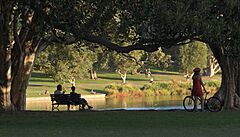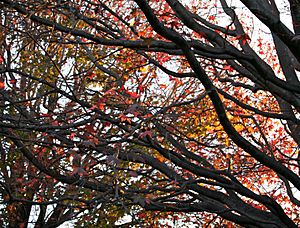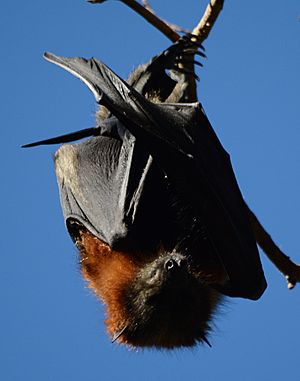Centennial Parklands facts for kids
Quick facts for kids Centennial Park |
|
|---|---|
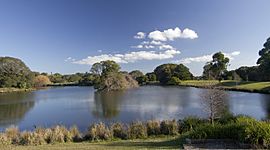
Centennial Park
|
|
| Lua error in Module:Location_map at line 420: attempt to index field 'wikibase' (a nil value). | |
| Type | Urban park |
| Location | Eastern Suburbs of Sydney, New South Wales, Australia |
| Area | 360 hectares (890 acres) |
| Created | 1816 |
| Founder | Governor Lachlan Macquarie |
| Operated by | Centennial Park & Moore Park Trust trading as the Botanic Gardens and Centennial Parklands |
| Open | Dawn to dusk |
| Status | Open all year |
| Designation | New South Wales Heritage Register |
| Public transit access | |
| Official name | Centennial Park, Moore Park, Queens Park; Centennial Parklands; Sydney Common; Lachlan Swamps Water Reserve |
| Type | State heritage (landscape) |
| Criteria | a., c., d., e. |
| Designated | 27 March 2000 |
| Reference no. | 1384 |
| Type | Urban Park |
| Category | Parks, Gardens and Trees |
Centennial Parklands is a group of three large parks in the eastern suburbs of Sydney, New South Wales, Australia. These parks are Centennial Park, Moore Park, and Queens Park. Together, they cover about 360 hectares (890 acres) and are managed by the Centennial Park & Moore Park Trust.
The Parklands are very important historically and naturally. They are listed on the New South Wales Heritage Register because of their special features. You can find many wild animals here, especially birds, rabbits, and foxes. There are also places for horse riding and even a special boarding facility for rabbits!
Contents
History of the Parklands
Early History and Indigenous People
The land where Centennial Parklands now stands was originally home to the Gadigal people. They lived here for thousands of years, managing the land and hunting animals like kangaroos. Maps from the late 1700s show an area called "Kangaroo Ground," which was likely kept clear by the Gadigal people to attract game.
The Parklands have a long history, starting with the arrival of European settlers. In 1811, Governor Lachlan Macquarie set aside this land as the "Sydney Common" for public use.
Water Supply for Sydney
The Sydney Common was important because it had a good supply of fresh water from the Lachlan Swamps. From 1830 to 1880, these swamps were Sydney's main water source. A long tunnel called Busby's Bore was built to carry water from the swamps all the way to Hyde Park in the city.
From Common Land to Public Parks
In the late 1800s, people wanted a large public park for recreation, similar to grand parks in other big cities. Sir Henry Parkes, the premier of New South Wales, helped make this idea a reality.
Charles Moore, who was the Mayor of Sydney, worked to create public parks. He helped develop Moore Park and Randwick Road. Another Charles Moore, a botanist, helped design the planting for Centennial Park.
Moore Park's Development
In 1866, a part of the Sydney Common was set aside as a recreation area. It was named Moore Park in 1867 after Mayor Charles Moore. This park became a hub for sports and entertainment.
The Sydney Showground, home to the famous Royal Agricultural Society of New South Wales' Easter Show, was located here from 1882 until 1997. It attracted huge crowds every year. Moore Park also hosted Sydney's second zoo from 1879 to 1916, before the animals moved to Taronga Zoo.
Queens Park's Beginnings
Queens Park was also created in 1887 as part of the celebrations for Australia's 100th anniversary. It was built on swampy land and has been used for sports fields since the 1930s. Today, it's still a popular spot for local sports teams.
Centennial Park's Grand Opening
Centennial Park was officially opened on January 26, 1888, to celebrate 100 years since the European settlement of Australia. Sir Henry Parkes called it "the people's park." Hundreds of unemployed men helped transform the sandy land into the beautiful park we see today.
The park's design was influenced by famous parks in England. It features grand avenues, ornamental ponds, and many different types of trees.
Federation of Australia
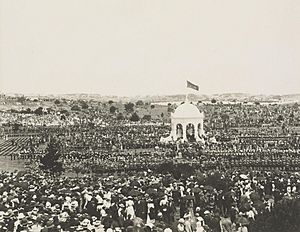
A very important event happened in Centennial Park on January 1, 1901. This was the official ceremony where the Australian colonies united to form the Commonwealth of Australia. Lord Hopetoun became the first Governor-General, and Edmund Barton became the first Prime Minister.
A special pavilion was built for the ceremony. Today, a permanent Federation Pavilion stands over the "Commonwealth Stone," which marks the exact spot where Australia became a nation.
Planting and Wildlife
Over the years, many different plants and trees have been added to the park. Early botanists experimented with various species, including native Australian plants like eucalypts and paperbarks. These plantings helped create the diverse landscapes we see today.
The park is home to over 15,000 trees and many bird species. It also has wetlands and lakes that provide homes for water birds, turtles, and eels.
Special Events and Activities
Centennial Parklands has always been a place for big events. It has hosted military parades, the Royal Easter Show, and parts of the Sydney 2000 Olympic Games (for road cycling and marathons).
Today, the parklands continue to host concerts, sporting events, and community gatherings. In 2013, the park celebrated its 125th anniversary with special events, including a children's garden. Many people visit the park every year for walking, cycling, horse riding, and enjoying nature.
Centennial Park
Centennial Park is the largest of the three parks, covering 189 hectares (467 acres). It's known for its beautiful formal gardens, ponds, grand avenues, and statues. It's a popular spot for many activities.
Centennial Park Labyrinth
In 2014, Sydney's first public stone labyrinth was opened in Centennial Park. It's a beautiful eleven-circuit design, inspired by the famous labyrinth in Chartres Cathedral in France. It's a peaceful place for walking and reflection.
Wildlife in Centennial Park
Centennial Park is a haven for wildlife. You can spot pelicans, black swans, different kinds of ducks, and other water birds like purple swamphens and Common moorhens. The ponds are also home to turtles and eels. A large colony of flying foxes (grey-headed flying foxes) has been roosting in the Lachlan Swamp since 2010.
Grand Drive
Grand Drive is the main circular road that goes through Centennial Park. It's 3.8 kilometers (2.4 miles) long and was part of the marathon course for the Sydney 2000 Olympics. The drive has different lanes for cycling, driving, walking, and horse riding.
Moore Park
| Moore Park | |
|---|---|

The rotunda at Moore Park (west)
|
|
| Type | Urban park |
| Location | Sydney, New South Wales, Australia |
| Area | 115 hectares (280 acres) |
| Created | 1869 |
| Status | Open all year |
| Designation | New South Wales Heritage Register |
Moore Park is a large urban park with 115 hectares (284 acres) of open spaces and playing fields. It includes the ES Marks Athletics Field, an 18-hole public golf course, tennis courts, and netball courts. It's also used for circuses and other outdoor events. The nearby Sydney Football and Sydney Cricket stadia are also part of this area.
The Albert Cotter Bridge connects different parts of Moore Park over Anzac Parade. A section of Busby's Bore, Sydney's old water tunnel, runs underneath parts of Moore Park.
History of Moore Park
Moore Park was named after Charles Moore, a Mayor of Sydney, who wanted the land to be a leisure area for everyone. Sydney's first zoo was here from 1879 until 1917. Today, Sydney Girls High School and Sydney Boys High School are located on the former zoo site.
The heritage-listed Moore Park Golf House, opened in 1926, offers great views of the golf course. A historic sandstone building from 1860, which used to be a toll house, is still standing at the corner of Anzac Parade and Alison Road.
Queen's Park
| Queen's Park | |
|---|---|
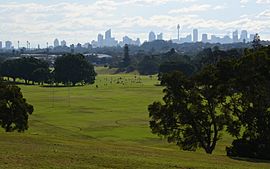 |
|
| Type | Urban park |
| Location | Sydney, New South Wales, Australia |
| Area | 26 hectares (64 acres) |
| Created | 1888 |
| Status | Open all year |
Queen's Park is a 26-hectare (64-acre) urban park with beautiful views of the city. It was created in 1888 as part of the Centennial celebrations. The park has many playing fields and is used by local schools and sports groups.
The park has undergone renovations to improve its playing fields and children's playground. A shared cycleway also connects it to the wider eastern suburbs cycle network.
Why the Parklands are Special
Centennial Parklands is a unique and important place. It's a large, beautiful open space with a rich history and natural environment.
Natural Wonders
The Parklands are a special place for nature in Sydney. They help keep the local environment healthy and provide homes for many different plants and animals. You can find rare and endangered species here, as well as remnants of the "Eastern Suburbs Banksia Scrub," a type of plant community that used to cover much of this area. The wetlands and lakes are vital habitats for wildlife.
Indigenous Heritage
This land has been important to the Gadigal people for thousands of years. They used the springs, wetlands, and plants for food, water, and cultural activities. Today, the Parklands continue to be a significant cultural landscape for Indigenous Australians.
Cultural Importance
Centennial Parklands is loved for its beauty, size, and diverse history. It has played a big role in the story of New South Wales and Australia. It was the site of the Centenary celebrations in 1888, the birth of the Commonwealth of Australia in 1901, and events for the Sydney 2000 Olympic Games.
The Parklands are also important for sports and recreation. They were created for public enjoyment and have been a popular place for people to gather, play, and relax for over a century. Millions of people visit the Parklands every year, enjoying its open spaces and many activities.
Images for kids
See also
- Centennial Park, the suburb
- Disney Studios Australia
- Queens Park, the suburb
- Moore Park, the suburb
- Sydney Cricket Ground
- Sydney Football Stadium
- Sydney Showground (Moore Park)
- The Entertainment Quarter
- List of parks in Sydney



